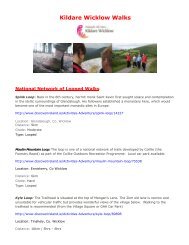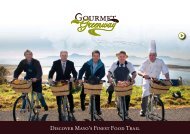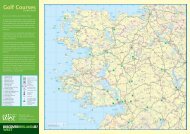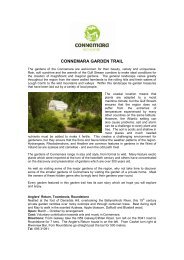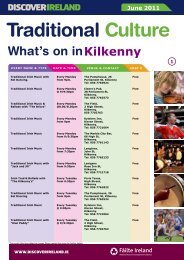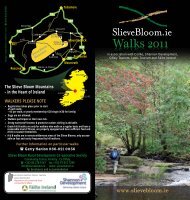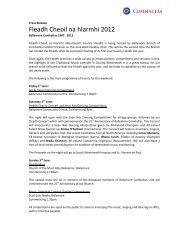Boyne Valley brochure [pdf, 8.03MB] - Discover Ireland
Boyne Valley brochure [pdf, 8.03MB] - Discover Ireland
Boyne Valley brochure [pdf, 8.03MB] - Discover Ireland
Create successful ePaper yourself
Turn your PDF publications into a flip-book with our unique Google optimized e-Paper software.
Spire of Lloyd<br />
The only inland lighthouse in <strong>Ireland</strong>, The<br />
Spire of Lloyd is an 18th century “folly’’<br />
Follies were decorative buildings commonly erected during the 18th<br />
century. Built in 1791, it resembles a giant Doric column topped<br />
with a glazed lantern.<br />
The Spire had a commemorative rather<br />
than functional purpose: it was erected to<br />
the memory of Thomas Taylor, I st Earl of<br />
Bective, by his son. Yet it is called the Spire<br />
of Lloyd since it sits on the Hill of Lloyd,<br />
named after Thomas Lloyd of Enniskillen.<br />
The Spire stands at 30 metres (100ft)<br />
tall, and offers wonderful vistas of the<br />
surrounding countryside. On a clear day,<br />
it is possible to see as far as the Mourne<br />
Mountains in Co. Down.<br />
Did you know? In the 19th Century,<br />
the Spire was used to view horseracing<br />
and hunts.<br />
GPS: 53.730616, -6.908040<br />
Patrickstown<br />
Viewing Point<br />
It is possible to walk up Patrick’s Hill from<br />
the viewing point at Patrickstown. Part<br />
of the Loughcrew complex of passage<br />
tombs, Patrick’s Hill has several ‘’cairns’’ (or<br />
mounds) which conceal Neolithic passage<br />
tombs. There are also the remains of<br />
several standing stones.<br />
Patrick’s Hill is one of three hilltops that<br />
make up Loughcrew; the site itself spans<br />
a ridge of land that runs roughly eastwest<br />
across the middle of <strong>Ireland</strong>. The<br />
Loughcrew hills are the highest in Co.<br />
Meath, and are each peppered with various<br />
monuments. The other hills in the complex<br />
are Carnbane West and Carnbane East.<br />
Oldcastle<br />
The town of Oldcastle was the 18th century<br />
creation of the Naper family, who received<br />
parts of the Plunkett estate following<br />
the cromwellian wars. Due in part to the<br />
continuation of a Gaelic way of life, the area<br />
suffered badly during the Great Famine<br />
(1845-‘9) in comparison with richer, more<br />
arable and more progressive areas in the<br />
southern part of Co. Meath. The poorest<br />
inhabitants were obliterated by starvation<br />
and emigration. Nonetheless, land<br />
patterns still visible today reveal a strong<br />
attachment to pastoral farming of<br />
’Gaelic’ culture.<br />
GPS: 53.770124, -7.162657<br />
GPS: 53.749760, -7.085113<br />
48 FOR MORE INFORMATION GO TO WWW.BOYNEVALLEYDRIVE.IE FOR MORE INFORMATION GO TO WWW.BOYNEVALLEYDRIVE.IE 49


![Boyne Valley brochure [pdf, 8.03MB] - Discover Ireland](https://img.yumpu.com/13306944/50/500x640/boyne-valley-brochure-pdf-803mb-discover-ireland.jpg)
